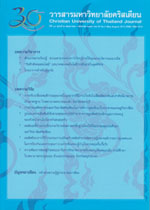รูปแบบความสัมพันธ์เชิงสาเหตุของการให้อำนาจ ความผูกพันต่อองค์กร และการคงอยู่ของหัวหน้างานในวิสาหกิจครอบครัว
บทคัดย่อ
การวิจัยนี้มีวัตถุประสงค์เพื่อศึกษาถึงองค์ประกอบการให้อำนาจของหัวหน้างานในวิสาหกิจครอบครัว และทดสอบรูปแบบความสัมพันธ์เชิงสาเหตุของการให้อำนาจต่อความผูกพันต่อองค์กร และการคงอยู่ของหัวหน้างาน โดยพัฒนากรอบแนวคิดจากทฤษฎีการให้อำนาจเชิงโครงสร้างของ Kanter,1979 และแนวคิดการให้อำนาจเชิงจิตวิทยาของ Thomas & Velthouse,1990 และ Spreitzer,1995 เครื่องมือที่ใช้ในการวิจัยเป็นแบบสอบถามที่ผู้วิจัยพัฒนาขึ้นมา โดยค่าความเชื่อมั่นของแบบสอบถามเท่ากับ 0.9641 วิเคราะห์ข้อมูลโดย การวิเคราะห์องค์ประกอบเชิงยืนยัน การวิเคราะห์เส้นทาง และการตรวจสอบความสอดคล้องระหว่างรูปแบบตามสมมุติฐานกับข้อมูลเชิงประจักษ์ ผลการวิจัยพบว่า องค์ประกอบการให้อำนาจของหัวหน้างานประกอบด้วยการให้อำนาจเชิงโครงสร้างและเชิงจิตวิทยา รูปแบบความสัมพันธ์เชิงสาเหตุของการให้อำนาจต่อความผูกพันต่อองค์กรและการคงอยู่ของหัวหน้างาน มีความสอดคล้องกับข้อมูลเชิงประจักษ์ และ การให้อำนาจเชิงจิตวิทยามีค่าน้ำหนักและค่าสัมประสิทธิ์การถดถอยมากกว่าการให้อำนาจเชิงโครงสร้าง การให้อำนาจของหัวหน้างานมีอิทธิพลโดยตรงต่อความผูกพันต่อองค์กรและการคงอยู่ของหัวหน้างาน การให้อำนาจยังมีอิทธิพลทางอ้อมต่อการคงอยู่ของหัวหน้างานผ่านความผูกพันต่อองค์กร
เอกสารอ้างอิง
ภัทรวุฒิ สมสาย. (2550). ความสัมพันธ์ระหว่างการรับรู้การเสริมสร้างพลังอำนาจในงานและความผูกพันต่อองค์การของพนักงานระดับปฏิบัติการ : กรณีศึกษา บริษัทปูนซิเมนต์นครหลวง จำกัด (มหาชน) โรงงานสระบุรี. วิทยานิพนธ์ศิลปศาสตรมหาบัณฑิต. บัณฑิตวิทยาลัย, มหาวิทยาลัยเกษตรศาสตร์.
วิริยา แก้วสง่า. (2553). ปัจจัยที่มีอิทธิพลต่อการคงการทำงานของแพทย์ในโรงพยาบาลชุมชน สังกัดกระทรวงสาธารณสุข จังหวัดเชียงใหม่. การค้นคว้าแบบอิสระหลักสูตรบริหารธุรกิจ บัณฑิตวิทยาลัย มหาวิทยาลัยเชียงใหม่.
สุเทพ พงศ์ศรีวัฒน์. (2548). ภาวะผู้นำ : ทฤษฎีและปฏิบัติ. พิมพ์ครั้งที่ 2. กรุงเทพฯ : บริษัท วิรัตน์เอ็ดดูเคชั่น จำกัด.
สุรีย์ ท้าวคำลือ และพนิดา ดามาพงศ์. (2550). ปัจจัยคัดสรรที่ทำนายความตั้งใจที่จะคงอยู่ในงานของพยาบาลวิชาชีพโรงพยาบาลเอกชน เขตกรุงเทพมหานคร. วารสารพยาบาลศาสตร์ มหาวิทยาลัยนเรศวร. 1(1) : 92-105.
สำนักงานสถิติแห่งชาติ. (2549). วิสาหกิจขนาดกลางและขนาดย่อม. [ออนไลน์]. สืบค้นเมื่อวันที่ 11 กรกฏาคม 2553, จาก www.nso.go.th/?.
Asiya Gul, Sajjad Akbar and Zeb Jan. (2012). Role of capacity development, employer empowerment and promotion on employee retention in the banking sector of pakistan. International Journal of Academic Research in Business and Social Science. September 2(9) : 284-300.
Baston, V. (2004). Shared governance in an integrated health care network. AORN, 80(3) : 493-496, 498, 501-504, 506, 509-512.
Bryman, A., and Cramer, D. (1999). Quantitative data analysis with spss release 8 for windows : aguide for social scientists. London, Rontledge published.
Conger, J.A. & Kanungo. (1988). The empowerment process: Integrating theory and practice. Academy of Management Review. 13(3) : 471-482.
Ekeberg C., M. Lagerstrom and K. Lutzen. (1997). Empowerment and occupational health nursing. A conceptual framework for reducing role ambiguity and facilitating client empowerment. AAOHN J. Jul 45(7) : 342-348.
Geroy, G. (1998). Strategic performance empowerment model. Empowerment in Organizations, 6(2) : 57-65.
Greasley, K. (2005). Employee perceptions of empowerment. Employee Relations, 27(4) : 354-368.
Joseph, L., Gene, A., Alex, N. & Frank, T. (2009). Employee retention : A business case for engagement. In Air Force Research Laboratory.
Kanter, R. M. (1979). Power failure in management circuits. Harvard Business Review, (57) : 65-75.
Kinlaw, Dennis C. (1995). The practice of empowerment : Making the most of human competence. Hampshire : Gower Publishing Limited.
Klein, K.J., Ralls, R.S., Smith-Major, V., & Douglas. (1998). Power and participation in the workplace : implications for empowerment theory, research and practice. University of Maryland at College Park Working Paper. College Park, MD.
Kluska, K.M., Laschinger-Spence, H. K., & Kerr, M. S. (2004). Staff nurse empowerment and effort-reward imbalance. Canadian Journal of Nursing Leadership, 17(1) : 112-128.
Laschinger, H. K. S. (1996). A theoretical approach to study work empowerment in nursing, a review of studies testing Kanter's theory of structural power in organization. Journal of Nursing Administration 20 (Winter 1996) : 26-28. Cited R.M. Kanter. (1977). Men and Women of the Corporation. New York: Basic Book.
Laschinger, H.K.S., Finegan, J., Shamian, J., & Casier, S. (2000). Organizational trust and empowerment in restructured heaithcare setting: Effect on staff nurse commitment. Journal of Nursing Administration, 30(9) : 413-425.
Lawler, E.E., S. Mohrman and G. Benson. (2001). Organizing for high performance : The CEO report on employee involvement, TQM, reengineering and knowledge management in fortune 1000 companies. San Francisco : Jossey-Bass.
McDermont, K., Laschinger, H. K. S., & Shamian, J. (1996). Work empowerment and organizational commitment. Nursing Management, 27(5) : 44-48.
Menon, J. (1995). The Dynamics of Intra-industry Trade in ASEAN. Asian Economic Journal, 9(1) : 105-115.
Samuel and Empl. (2009). Employee retention and turnover: Using motivational variables as a panacea. African Journal of Business Management, September 3(8) : 410-415.
Scott, C. D. and D. A. Jaffe. (1992). Empowerment : Building & Committed workforce. California : Crisp Publication Inc.
Smith, J. (2000). Empowering people. [Online]. Retrieved March 2, 2007, from https://www.koganpage.co.uk/bookdetails.aspx.
Spreitzer, G. & Doneson, D. (2005). Musings on the past and future of employee empowerment. forthcoming in the handbook of organization development. Tom Cummings ed. .Thousand Oaks : Sage.
Spreitzer, G. M. (1995). Psychological empowerment in the workplace : Dimensions, measurement, and validation. Academy of Management Journal, 38(5) : 1442-1465.
Stewart, A. M. (1994). Empowering people. London : Pitman.
Tebbitt, B. V. (1993). Demystifying organizational empowerment. Journal of Nursing Administration, 23(1) : 18-23.
The role of front line manager in HR. [Online]. Retrieved July, 2010,from https://www.cipd.co.uk/subjects/maneco/general/rolefrntlinemngers.htm.
Thomas, K. W., & Velthouse, B. A. (1990). Cognitive element of empowerment. Journal of Nursing Administration, 23(1) : 18-23.
Wilkinson, A. (1998). Empowerment : Theory and practice. Personnel Review, 27(1) : 40-46.
Wilson, B., & Laschinger, H. K. S. (1994). Staff nurses' perception of job empowerment and organizational commitment: A test theory of Structural Power in Organizations. Journal of Nursing Administration, 24(4s) : 39-45.



